Decentralized Operations of Industrial Complex Microgrids Considering Corporate Power Purchase Agreements for Renewable Energy 100% Initiatives in South Korea
Abstract
:1. Introduction
1.1. Literature Reviews
1.2. Contributions
- Decentralized OPF Method for RE100 Implementation in ICMGs: Even though the proposed mathematical model is already well-established in the state-of-the-art literature, there has been limited research on decentralized operations considering corporate PPAs between companies and renewable energy providers using this mathematical model, despite the growing societal demand for RE100 implementation by companies within ICMGs. In particular, the focus on RE100 implementation through corporate PPAs is a novel area that has not been extensively explored in the existing literature. Therefore, this paper contributes by proposing a decentralized OPF method using the SALR algorithm to address power transactions between interconnected ICMGs for RE100 implementation through corporate PPAs. This approach aims to reduce power transaction costs for ICMGs while enabling companies to achieve their sustainability goals for RE100 implementation.
- Power Transactions Considering the Privacy of Internal Data in Grid-Connected and Islanded Modes: Our method addresses the unique challenges of managing power transactions between ICMGs in both grid-connected and islanded modes, depending on whether the ICMG is connected to the main power system. In each mode, internal power usage data of different ICMG operating entities must be shared, which can lead to information security issues for RE100 participating companies within the ICMGs. The proposed method determines optimal energy transactions between two ICMGs by sharing only transaction prices and amounts, using iterative updates of augmented Lagrangian multipliers. These multipliers can be economically interpreted as the unit prices of transacted energy. Therefore, this paper demonstrates that power transactions can be optimized using the SALR algorithm without disclosing internal information in each mode, providing ICMG operators with an operational strategy to address information security concerns.
- Economic Analysis and Practical Insights through Scenario and Sensitivity Analysis: This paper includes detailed economic analyses and sensitivity studies, providing practical insights into the feasibility and benefits of our approach in real-world scenarios. In the case study, we conducted sensitivity analysis based on actual time of use (ToU), supplementary supply (SSR) tariff scenarios, and PPA network fees in South Korea to assess the economic viability of the proposed method. By understanding how different tariff structures impact energy costs and generation, decision-makers can gain insights into which tariff plan to adopt and determine the appropriate PPA amounts for RE100 implementation.
2. Decentralized Operation Method for Power Transactions between ICMGs
2.1. Centralized Optimal Power Flow Model
2.2. Decomposition of Centralized OPF Problem Using the SALR Algorithm
2.3. Solution Searching Procedure for SALR-Based Decentralized OPF Method
- Step 1: Initialization.
- Step 2: Subproblem Solving.
- Step 3: Multiplier Updating.
- Step 4: Convergence Checking.
3. Case Study
3.1. Numerical Results of Grid-Connected Mode
- Tariff plan 1: Purchasing insufficient electricity from the retail market through the time of use (ToU) tariff plan.
- Tariff plan 2: Renewable energy providers purchase insufficient electricity from the retail market through the supplementary supply rate (SSR) and sell them to consumers for the balancing service.
3.2. Numerical Results of Islanded Mode
4. Conclusions
- Cost Reduction: By implementing the proposed decentralized OPF method, companies can achieve significant cost savings with the offsetting carbon credits. The sensitivity analysis of PPA network fees indicates that careful management and negotiation of these fees can lead to lower overall costs for implementing RE100 initiatives.
- Enhanced Decision-Making: The detailed analysis of different tariff plans (ToU and SSR) provides valuable insights for decision-makers. By understanding how different tariff structures impact energy costs and generator dispatch, managers can make more informed decisions about which tariff plan to adopt.
- Sustainability Goals: Our study demonstrates how corporate PPAs with renewable energy developers can be effectively managed to achieve RE100 targets. This not only helps in reducing the carbon footprint but also enhances the company’s reputation as a leader in sustainability.
- Strategic Planning: The findings from our study can aid in long-term strategic planning. By understanding the cost implications and operational impacts of different energy management strategies, companies can better plan their investments in renewable energy and energy efficiency technologies.
Author Contributions
Funding
Institutional Review Board Statement
Informed Consent Statement
Data Availability Statement
Acknowledgments
Conflicts of Interest
References
- Olivares, D.; Canizares, C.; Kazerani, M. A centralized optimal energy management system for microgrids. In Proceedings of the 2011 IEEE Power and Energy Society General Meeting, Detroit, MI, USA, 24–28 July 2011; pp. 1–6. [Google Scholar]
- Barklund, E.; Pogaku, N.; Prodanovic, M.; Hernandez-Aramburo, C.; Green, T. Energy management in autonomous microgrid using stability-constrained droop control of inverters. IEEE Trans. Power Electron. 2008, 23, 2346–2352. [Google Scholar] [CrossRef]
- Palma-Behnke, R.; Benavides, C.; Lanas, F.; Severino, B.; Reyes, L.; Llanos, J.; Saez, D. A microgrid energy management system based on the rolling horizon strategy. IEEE Trans. Smart Grid. 2013, 4, 996–1006. [Google Scholar] [CrossRef]
- Olivares, D.; Canizares, C.; Kazerani, M. A centralized energy management system for isolated microgrids. IEEE Trans. Smart Grid 2014, 5, 1864–1875. [Google Scholar] [CrossRef]
- Dimeas, A.; Hatziargyriou, N. Operation of a multiagent system for microgrid control. IEEE Trans. Power Syst. 2005, 20, 1447–1455. [Google Scholar] [CrossRef]
- Logenthiran, T.; Srinivasan, D.; Wong, D. Multi-agent coordination for DER in microgrid. In Proceedings of the 2008 IEEE International Conference on Sustainable Energy Technologies, Singapore, 24–27 November 2008; pp. 77–82. [Google Scholar]
- Zhang, J.; Long, B.; He, Y.; Chen, R.; Fan, L.; Li, B.; Gu, T.; Fu, X.; Li, H. Grouping consistency control strategy based on DMPC and energy storage unit constraints. Int. J. Electr. Power Energy Syst. 2023, 148, 108958. [Google Scholar] [CrossRef]
- Wang, R.; Yu, X.; Sun, Q.; Li, D.; Gui, Y.; Wang, P. The Integrated Reference Region Analysis for Parallel DFIGs’ Interfacing Inductors. IEEE Trans. Power Electron. 2024, 39, 7632–7642. [Google Scholar] [CrossRef]
- Shi, W.; Xie, X.; Chu, C.; Gadh, R. Distributed optimal energy management in microgrids. IEEE Trans. Smart Grid. 2015, 6, 1137–1146. [Google Scholar] [CrossRef]
- Wang, Z.; Chen, B.; Wang, J.; Kim, J. Decentralized energy management system for networked microgrids in grid-connected and islanded modes. IEEE Trans. Smart Grid 2015, 7, 1097–1105. [Google Scholar] [CrossRef]
- Li, Y.; Liu, N.; Zhang, J. Jointly optimization and distributed control for interconnected operation of autonomous microgrid. In Proceedings of the 2015 IEEE Innovative Smart Grid Technologies-Asia (ISGT ASIA), Bangkok, Thailand, 3–6 November 2015; pp. 1–6. [Google Scholar]
- Song, N.-O.; Lee, J.-H.; Kim, H.-M.; Im, Y.H.; Lee, J.Y. Optimal Energy Management of Multi-Microgrids with Sequentially Coordinated Operations. Energies 2015, 8, 8371–8390. [Google Scholar] [CrossRef]
- Song, N.-O.; Lee, J.-H.; Kim, H.-M. Optimal Electric and Heat Energy Management of Multi-Microgrids with Sequentially-Coordinated Operations. Energies 2016, 9, 473. [Google Scholar] [CrossRef]
- Iris, Ç.; Lam, J.S.L. Optimal energy management and operations planning in seaports with smart grid while harnessing renewable energy under uncertainty. Omega 2021, 103, 102445. [Google Scholar] [CrossRef]
- Nunna, H.S.V.S.K.; Doolla, S. Demand response in smart distribution system with multiple microgrids. IEEE Trans. Smart Grid 2012, 3, 1641–1649. [Google Scholar] [CrossRef]
- Nunna, H.S.V.S.K.; Doolla, S. Multiagent-Based Distributed-Energy-Resource Management for Intelligent Microgrids. IEEE Trans. Ind. Electron. 2013, 60, 1678–1687. [Google Scholar] [CrossRef]
- Wang, Z.; Wang, L. Adaptive negotiation agent for facilitating bidirectional energy trading between smart building and utility grid. IEEE Trans. Smart Grid 2013, 4, 702–710. [Google Scholar] [CrossRef]
- Lu, R.; Bai, R.; Ding, Y.; Wei, M.; Jiang, J.; Sun, M.; Xiao, F.; Zhang, H.T. A hybrid deep learning-based online energy management scheme for industrial microgrid. Appl. Energy 2021, 304, 117857. [Google Scholar] [CrossRef]
- Iris, Ç.; Lam, J.S.L. A review of energy efficiency in ports: Operational strategies, technologies and energy management systems. Renew. Sustain. Energy Rev. 2019, 112, 170–182. [Google Scholar] [CrossRef]
- Fontenot, H.; Dong, B. Modeling and control of building-integrated microgrids for optimal energy management—A review. Appl. Energy 2019, 254, 113689. [Google Scholar] [CrossRef]
- Zhang, J.; Kong, D.; He, Y.; Fu, X.; Zhao, X.; Yao, G.; Teng, F.; Qin, Y. Bi-layer energy optimal scheduling of regional integrated energy system considering variable correlations. Int. J. Electr. Power Energy Syst. 2023, 148, 108840. [Google Scholar] [CrossRef]
- Gregoratti, D.; Matamoros, J. Distributed energy trading: The multiple-microgrid case. IEEE Trans. Ind. Electron. 2015, 62, 2551–2559. [Google Scholar] [CrossRef]
- Liu, N.; Wang, C.; Cheng, M.; Wang, J. A Privacy-Preserving Distributed Optimal Scheduling for Interconnected Microgrids. Energies 2016, 9, 1031. [Google Scholar] [CrossRef]
- Sheble, G.B.; Fahld, G.N. Unit Commitment Literature Synopsis. IEEE Tans. Power Syst. 1994, 9, 128–135. [Google Scholar] [CrossRef]
- Wood, A.J.; Wollenberg, B.F.; Sheble, G.B. Power Generation, Operation and Control, 3rd ed.; Wiley: New York, NY, USA, 2013. [Google Scholar]
- Lowery, P.G. Generating Unit Commitment by Dynamic Programming. IEEE Trans. Power Appar. Syst. 1966, 85, 422–426. [Google Scholar] [CrossRef]
- Muckstadt, J.A.; Wilson, R.C. An Application of Mixed-Integer Programming Duality to Scheduling Thermal Generating Systems. IEEE Trans. Power Appar. Syst. 1968, 87, 1968–1978. [Google Scholar] [CrossRef]
- Ouyang, Z.; Shahidehpour, S.M. An Intelligent Dynamic Programming for Unit Commitment Application. IEEE Trans. Power Syst. 1991, 6, 1203–1209. [Google Scholar] [CrossRef]
- Virmani, S.; Imhof, K.; Jee, S.M. Implementation of a lagrangian Relaxation Based Unit Commitment Problem. IEEE Trans. Power Syst. 1989, 4, 1373–1379. [Google Scholar] [CrossRef] [PubMed]
- Muckstadt, J.A.; Koenig, S.A. An Application of Lagrange Relaxation to Scheduling in Power Generation Systems. Oper. Res. 1977, 25, 387–403. [Google Scholar] [CrossRef]
- Bluin, V.Y.; Lassiter, J.B.; Wiecek, M.M.; Fadel, G.M. Augmented Lagrangian Coordination for Decomposed Design Problems. In Proceedings of the 6th World Congress of Structural and Multidisciplinary Optimization, Rio de Janeiro, Brazil, 30 May–3 June 2005. [Google Scholar]
- Gasimov, R.N. Augmented Lagrangian Duality and Nondifferentiable Optimization Methods in Nonconvex Programming. J. Glob. Optim. 2002, 24, 187–203. [Google Scholar] [CrossRef]
- Castillo, E.; Mínguez, R.; Conejo, A.; García-Bertrand, R. Decomposition Techniques in Mathematical Programming; Springer: New York, NY, USA, 2006. [Google Scholar]
- Hamdi, A.; Mahey, P.; Dussault, J.P. A New Decomposition Method in Nonconvex Programming via a Separable Augmented Lagrangian. In Recent Advances in Optimization; Springer: Berlin, Germany, 1997. [Google Scholar]
- Moon, G.H.; Joo, S.K.; Lee, K.; Choi, J.S. Unit commitment by separable augmented Lagrangian relaxation. J. Electr. Eng. Technol. 2013, 3, 514–519. [Google Scholar] [CrossRef]
- Kim, Y.W. Decentralized Energy Transaction between Microgrids and Electric Vehicle Charging Coordination Considering Driving Patterns. Ph.D. Thesis, Korea University, Seoul, Republic of Korea, August 2017. [Google Scholar]
- Yoon, H.J. A Study on the Effects of the System Marginal Price Setting Mechanism of the Cost Function in Operating Modes of the Combined Cycle Power Plants in Korea Electricity Market. Korea Resour. Econ. Assoc. Korea Environ. Econ. Assoc. 2021, 30, 107–128. [Google Scholar]
- Korean Statistical Information Service, Statistical Database [Online]. Available online: https://kosis.kr/index/index.do (accessed on 11 April 2024).
- Korea Electric Power Corporation (KEPCO). Electricity Bill (Comprehensive)–Effective. 1 January 2021. Available online: https://online.kepco.co.kr/PRM025D00 (accessed on 11 April 2024).
- ASEM SMEs Eco Innovation Center. 2022 Carbon Emissions Management Guidelines for Small and Medium Sized Enterprises. Available online: http://aseic.or.kr/uploaded/board/ecopublishing/_8a05586d225e415b5836d328e58920fb1.pdf (accessed on 11 April 2024).
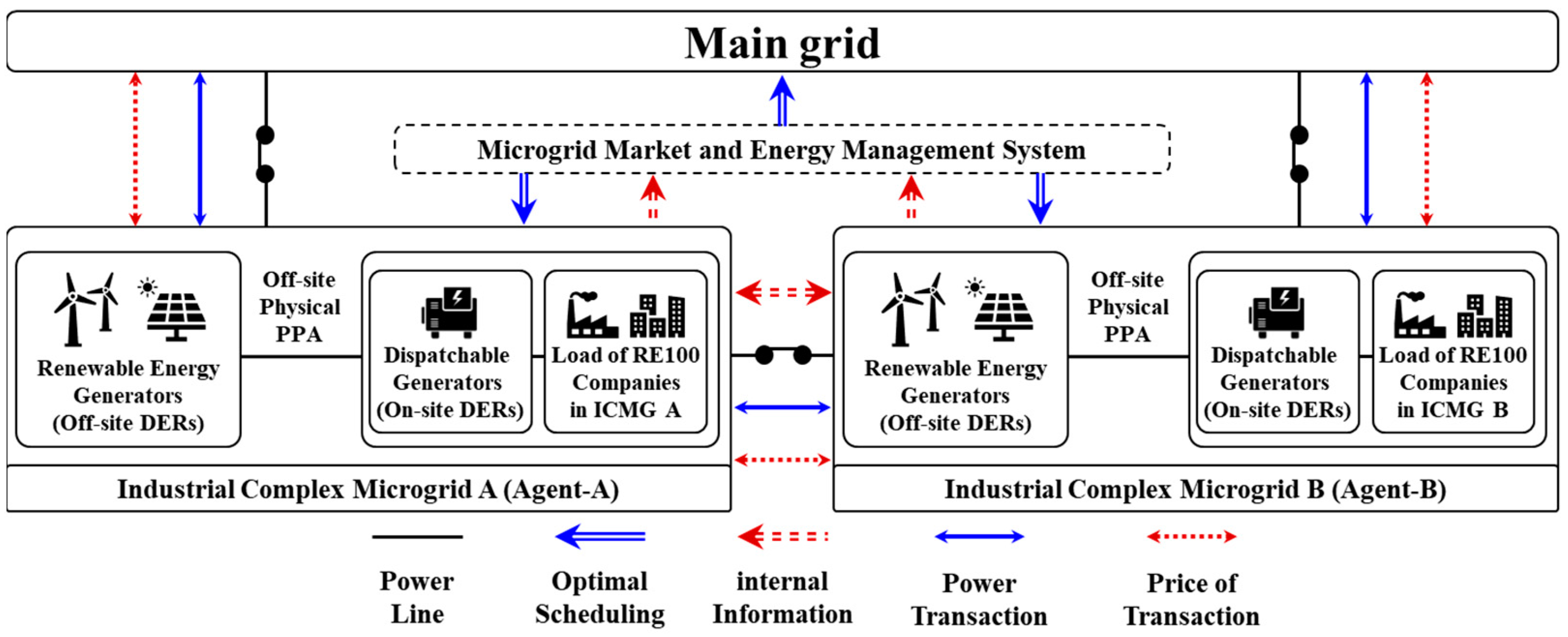
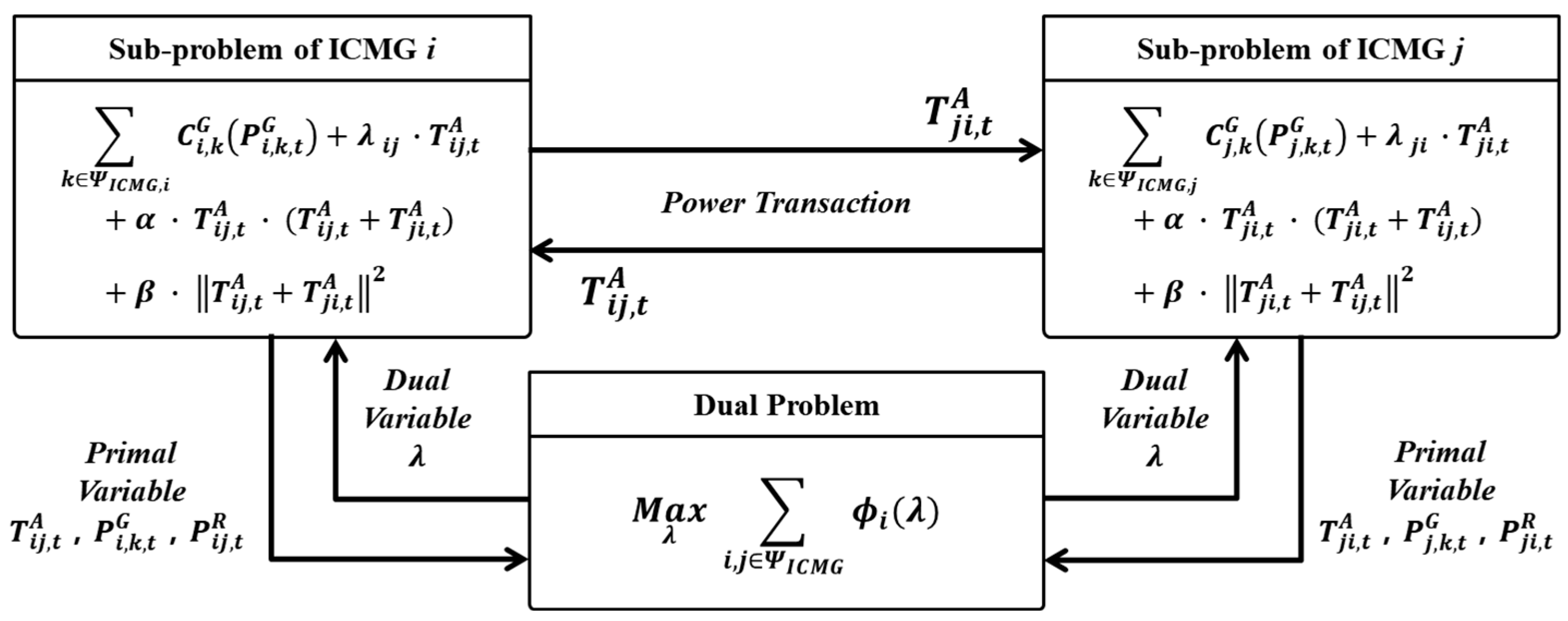



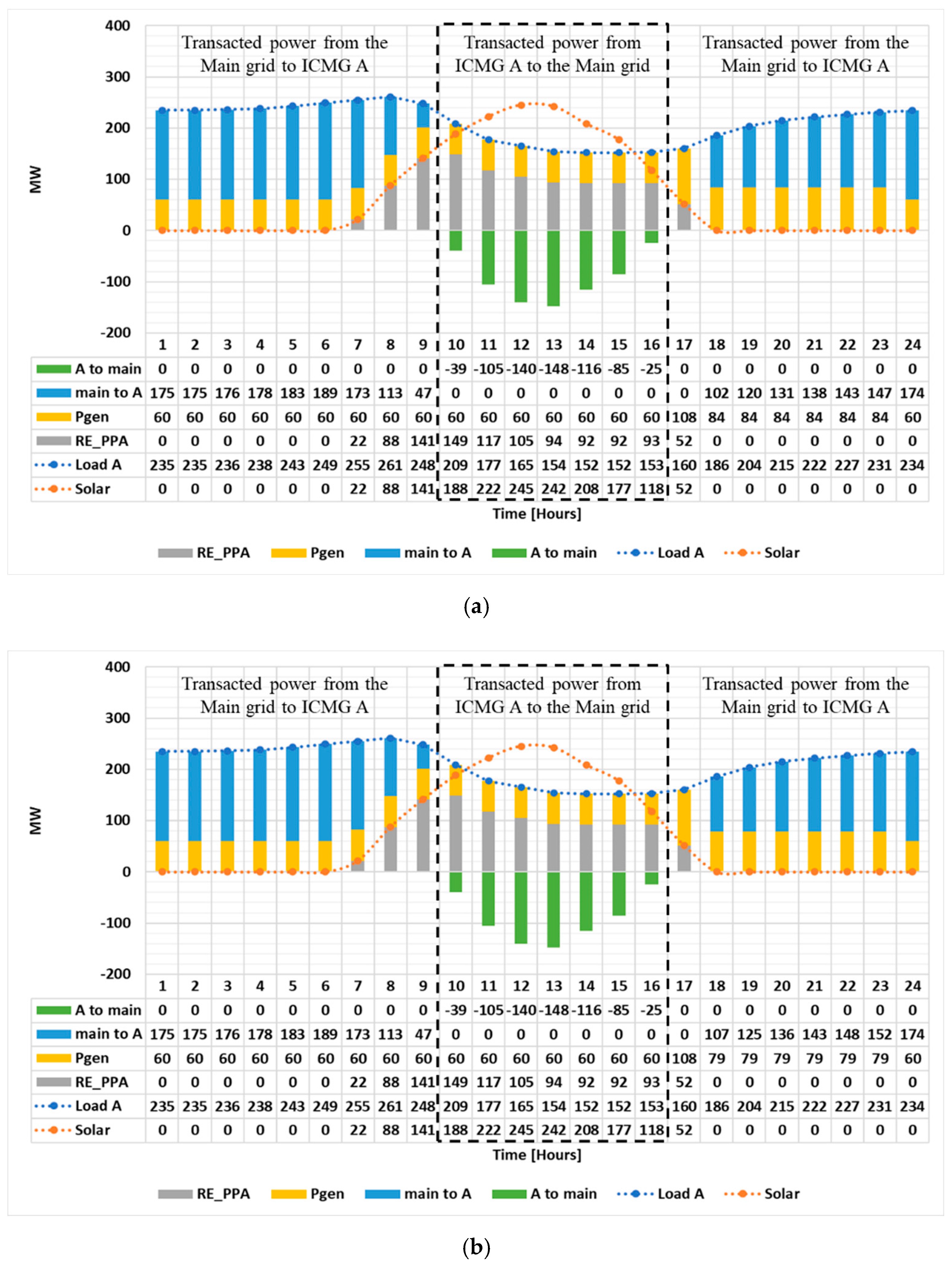
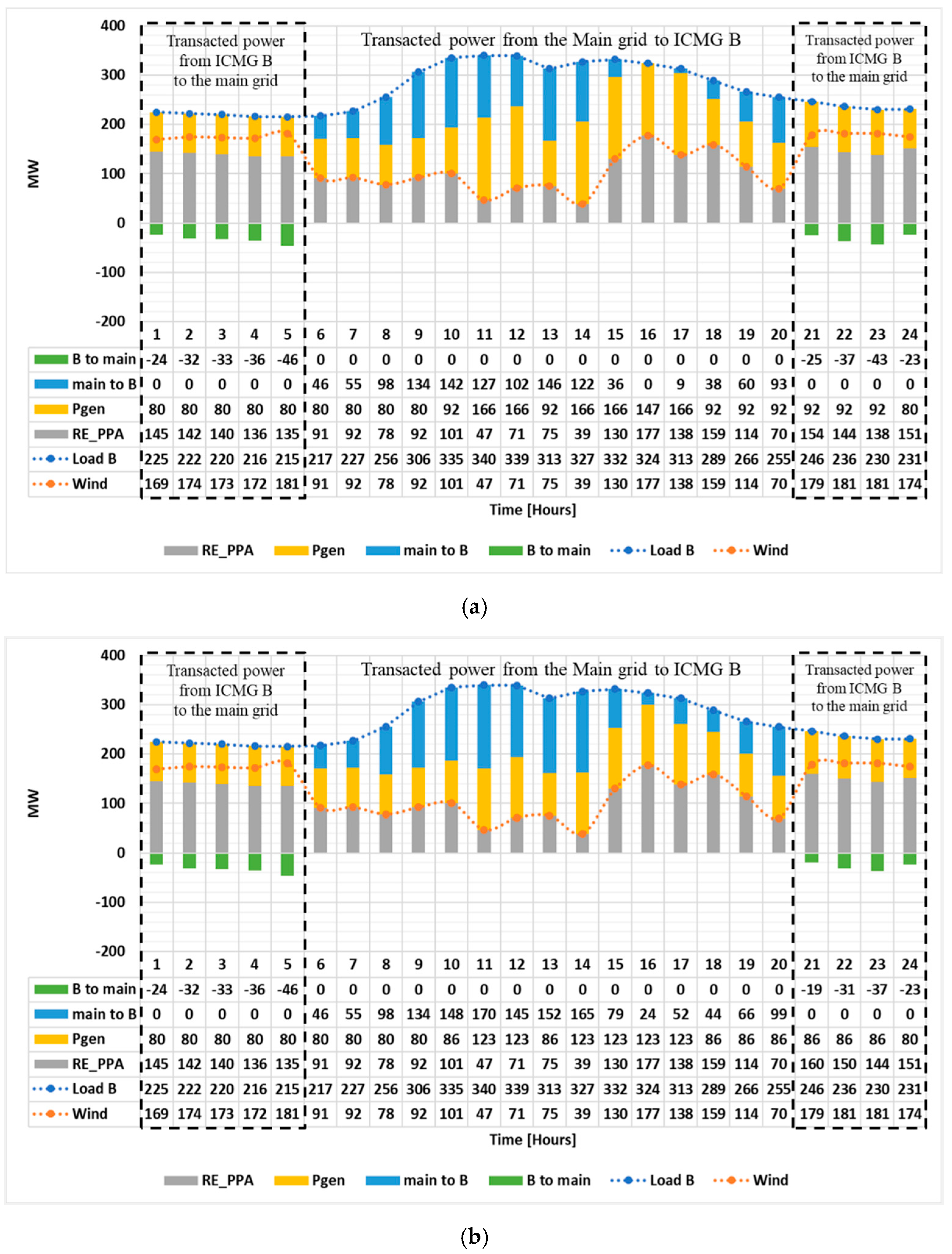
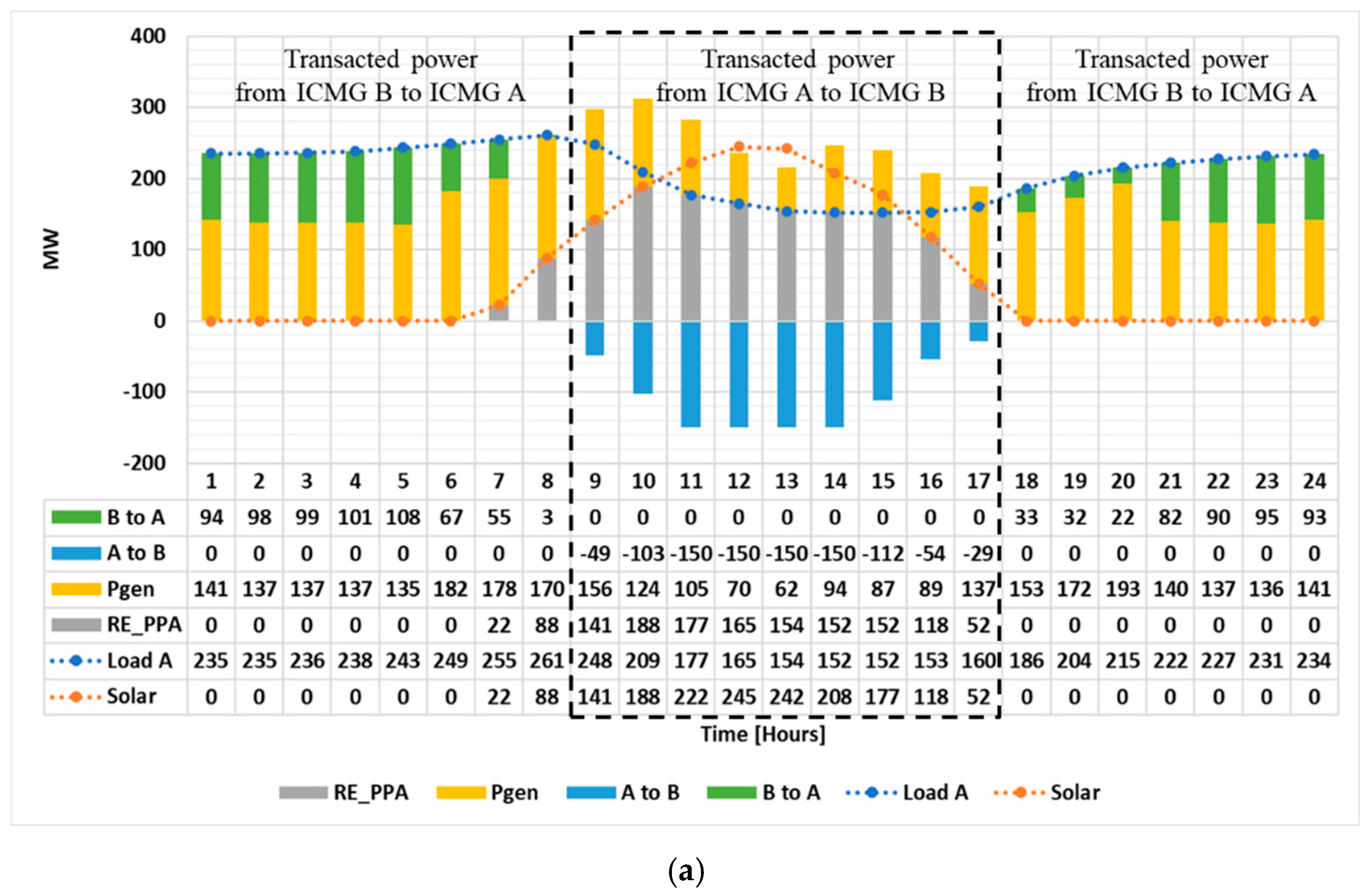
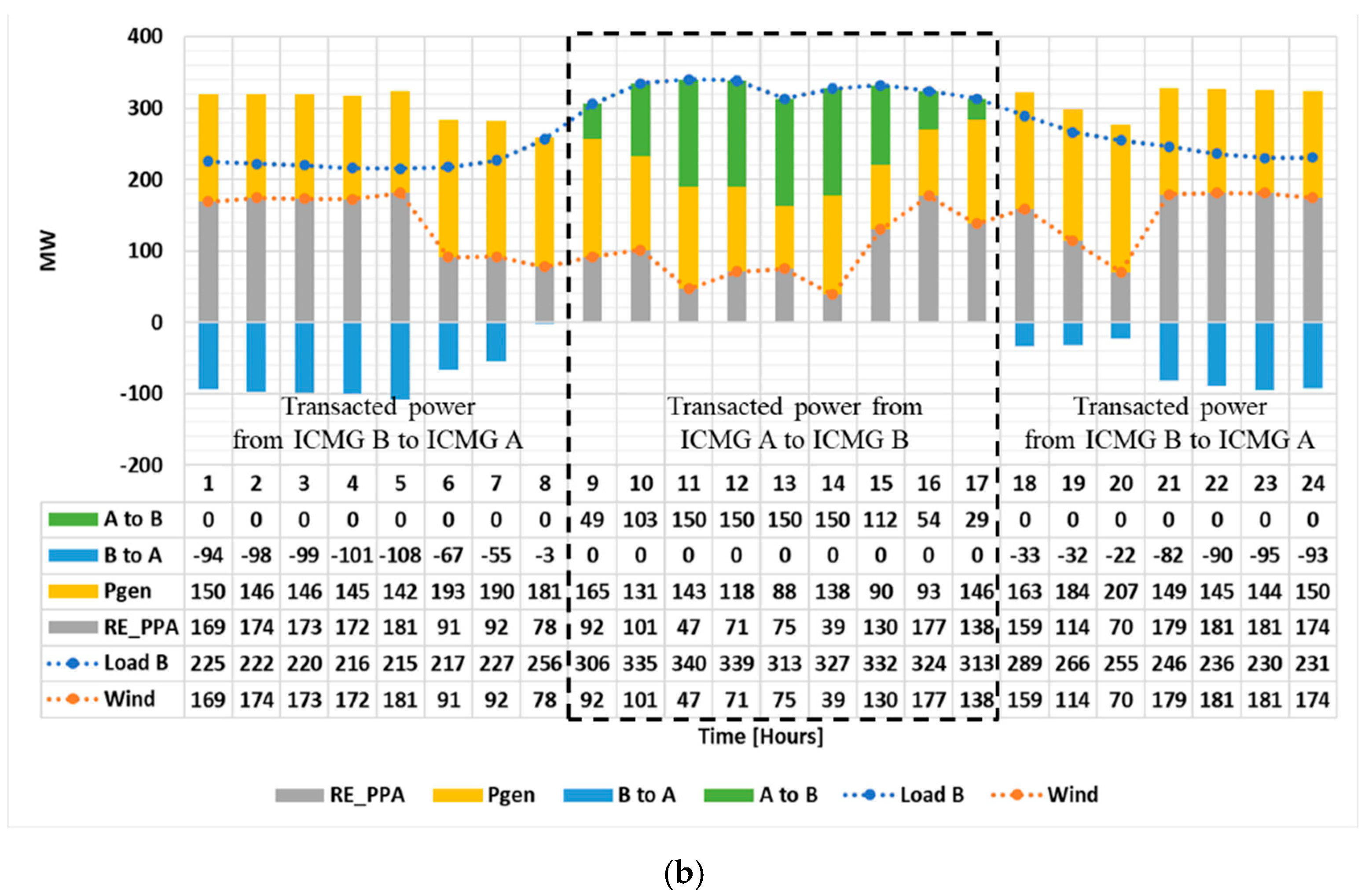
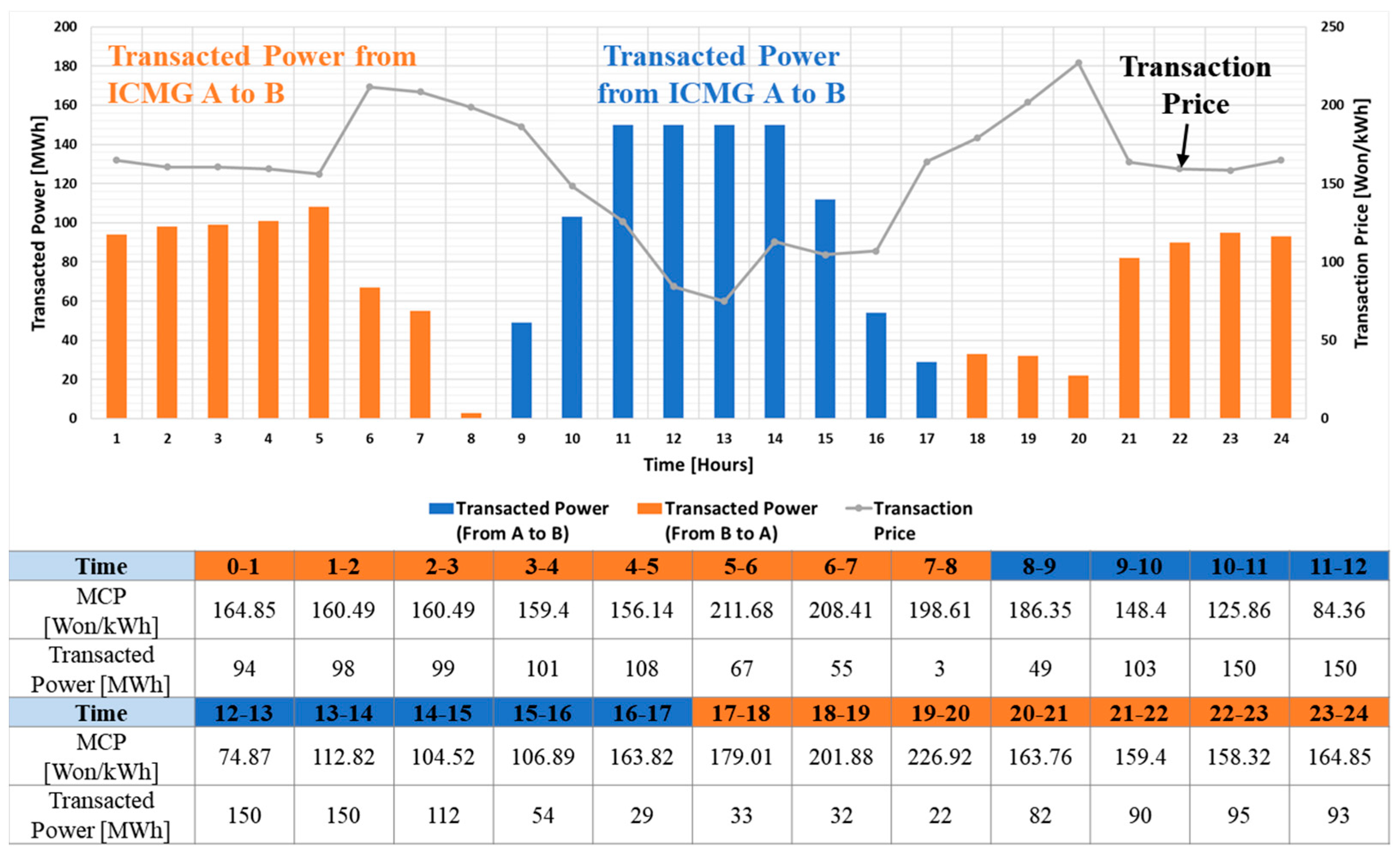
| ICMG | Technical Constraints | Cost Coefficients | |||
|---|---|---|---|---|---|
| Min. Power [MW] | Max. Power [MW] | [KRW] | [KRW/kWh] | ] | |
| A | 60 | 300 | 218.849077 | 1.332569 | 0.001186 |
| B | 80 | 400 | 150.827614 | 1.498456 | 0.001089 |
| Seasons | Summer | Spring and Autumn | Winter | |||
|---|---|---|---|---|---|---|
| ToU | SSR | ToU | SSR | ToU | SSR | |
| Off Peak | 49.5 | 65.0 | 49.5 | 65.0 | 56.6 | 65.0 |
| Medium | 101.8 | 95.8 | 71.9 | 70.8 | 101.8 | 79.1 |
| Peak | 183.1 | 136.2 | 102.2 | 81.6 | 158.0 | 96.7 |
| Time | 0–1 | 1–2 | 2–3 | 3–4 | 4–5 | 5–6 | 6–7 | 7–8 | 8–9 | 9–10 | 10–11 | 11–12 |
|---|---|---|---|---|---|---|---|---|---|---|---|---|
| SMP | 73.12 | 72.32 | 71.38 | 71.25 | 71.34 | 71.38 | 73.12 | 72.98 | 71.38 | 70.98 | 70.98 | 70.95 |
| ToU | 49.5 | 49.5 | 49.5 | 49.5 | 49.5 | 49.5 | 49.5 | 49.5 | 49.5 | 101.8 | 183.1 | 183.1 |
| SSR | 65.0 | 65.0 | 65.0 | 65.0 | 65.0 | 65.0 | 65.0 | 65.0 | 65.0 | 95.8 | 136.2 | 136.2 |
| Time | 12–13 | 13–14 | 14–15 | 15–16 | 16–17 | 17–18 | 18–19 | 19–20 | 20–21 | 21–22 | 22–23 | 23–24 |
| SMP | 70.94 | 70.94 | 78.51 | 70.94 | 71.93 | 73.48 | 73.74 | 76.32 | 75.95 | 75.95 | 75.95 | 74.04 |
| ToU | 101.8 | 183.1 | 183.1 | 183.1 | 183.1 | 101.8 | 101.8 | 101.8 | 101.8 | 101.8 | 101.8 | 49.5 |
| SSR | 95.8 | 136.2 | 136.2 | 136.2 | 136.2 | 95.8 | 95.8 | 95.8 | 95.8 | 95.8 | 95.8 | 65.0 |
| Names of Scenarios | ICMG A | ICMG B | |||
|---|---|---|---|---|---|
| ToU | SSR | ToU | SSR | ||
| PPA Network Fee | 15 [Won/kWh] | A-ToU-1 | A-SSR-1 | B-ToU-1 | B-SSR-1 |
| 10 [Won/kWh] | A-ToU-2 | A-SSR-2 | B-ToU-2 | B-SSR-2 | |
| 20 [Won/kWh] | A-ToU-3 | A-SSR-3 | B-ToU-3 | B-SSR-3 | |
| ICMG A (Dispatchable Generators) | Total Amount of Generation (kWh) | Generation Cost (Won) | |
|---|---|---|---|
| Scenarios A-ToU-1~3 | 1,632,000 | 138,811,200 | |
| Scenarios A-SSR-1~3 | 1,602,000 | 132,971,580 | |
| ICMG A (RES, etc.) | Price (Won/kWh) | Total amount of Electricity (kWh) | Total revenue (Won) |
| Renewable Energy (PPA) | 110 | 1,045,000 | 114,950,000 |
| Wholesale (SMP) | 70.94~78.51 | 658,000 | 47,329,130 |
| Scenarios A-ToU-1~3 | 49.5/101.8/183.1 | 2,364,000 | 157,864,300 |
| Scenarios A-SSR-1~3 | 65.0/95.8/136.2 | 2,394,000 | 180,588,800 |
| Scenarios of PPA Network fee | 15 (A-ToU/SSR-1) | 1,045,000 | 15,675,000 |
| 10 (A-ToU/SSR-2) | 10,450,000 | ||
| 20 (A-ToU/SSR-3) | 20,900,000 | ||
| Ratio of RE100 (%) | (1,045,000/5,041,000) × 100 = 20.73[%] | ||
| Offsetting Carbon Credits (Won) | eq] = 8,154,135 [Won] | ||
| ICMG B (Dispatchable Generators) | Total Amount of Generation (kWh) | Generation Cost (Won) | |
|---|---|---|---|
| Scenarios B-ToU-1~3 | 2,513,000 | 320,776,200 | |
| Scenarios B-SSR-1~3 | 2,226,000 | 236,321,300 | |
| ICMG B (RES, etc.) | Price (Won/kWh) | Total amount of Electricity (kWh) | Total revenue (Won) |
| Renewable Energy (PPA) | 110 | 2,759,000 | 303,490,000 |
| Wholesale (SMP) | 70.94~78.51 | 299,000 | 21,948,970 |
| Scenarios B-ToU-1~3 | 49.5/101.8/183.1 | 1,208,000 | 137,753,300 |
| Scenarios B-SSR-1~3 | 65.0/95.8/136.2 | 1,477,000 | 156,894,200 |
| Scenarios of PPA Network fee | 15 (B-ToU/SSR-1) | 2,759,000 | 41,385,000 |
| 10 (B-ToU/SSR-2) | 27,590,000 | ||
| 20 (B-ToU/SSR-3) | 55,180,000 | ||
| Ratio of RE100 (%) | (2,759,000/6,480,000) ×100 = 42.58[%] | ||
| Offsetting Carbon Credits (Won) | eq] = 21,528,477[Won] | ||
| ICMG A | Total Amount of Generation (kWh) | Generation Cost (Won) | |
|---|---|---|---|
| Dispatchable Generators | 3,213,000 | 547,101,207 | |
| ICMG A (RES, etc.) | Price (Won/kWh) | Total amount of Electricity (kWh) | Total revenue (Won) |
| Renewable Energy (PPA) | 110 | 1,409,000 | 154,990,000 |
| MCP (From ICMG A to B) | 97.33~181.18 | 947,000 | 106,330,869 |
| MCP (From ICMG B to A) | 161.44~230.23 | 1,072,000 | 181,821,658 |
| Scenarios of PPA Network fee | 15 | 1,409,000 | 21,135,000 |
| 10 | 14,090,000 | ||
| 20 | 28,180,000 | ||
| Ratio of RE100 (%) | (1,409,000/5,041,000) × 100 = 27.95[%] | ||
| Offsetting Carbon Credits (Won) | eq] = 10,994,427 [Won] | ||
| ICMG B | Total Amount of Generation (kWh) | Generation Cost (Won) | |
|---|---|---|---|
| Dispatchable Generators | 3,547,000 | 599,671,974 | |
| ICMG B (RES, etc.) | Price (Won/kWh) | Total amount of Electricity (kWh) | Total revenue (Won) |
| Renewable Energy (PPA) | 110 | 3,058,000 | 336,380,000 |
| MCP (From ICMG A to B) | 97.33~181.18 | 947,000 | 106,330,869 |
| MCP (From ICMG B to A) | 161.44~230.23 | 1,072,000 | 181,821,658 |
| PPA Network fee | 15 | 3,058,000 | 45,870,000 |
| 10 | 30,580,000 | ||
| 20 | 61,160,000 | ||
| Ratio of RE100 (%) | (3,058,000/6,480,000) × 100 = 47.19[%] | ||
| Offsetting Carbon Credits (Won) | eq] = 23,861,574 [Won] | ||
| Methods | Iteration Number | Simulation Time | ||
|---|---|---|---|---|
| CLR | SALR | CLR | SALR | |
| Min | 59 | 55 | 2.0 s | 1.7 s |
| Max | 690 | 79 | 25.4 s | 3.1 s |
| Average | 314 | 60 | 11.4 s | 2.3 s |
Disclaimer/Publisher’s Note: The statements, opinions and data contained in all publications are solely those of the individual author(s) and contributor(s) and not of MDPI and/or the editor(s). MDPI and/or the editor(s) disclaim responsibility for any injury to people or property resulting from any ideas, methods, instructions or products referred to in the content. |
© 2024 by the authors. Licensee MDPI, Basel, Switzerland. This article is an open access article distributed under the terms and conditions of the Creative Commons Attribution (CC BY) license (https://creativecommons.org/licenses/by/4.0/).
Share and Cite
Lee, J.; Shin, K.; Wi, Y.-M. Decentralized Operations of Industrial Complex Microgrids Considering Corporate Power Purchase Agreements for Renewable Energy 100% Initiatives in South Korea. Sustainability 2024, 16, 5440. https://doi.org/10.3390/su16135440
Lee J, Shin K, Wi Y-M. Decentralized Operations of Industrial Complex Microgrids Considering Corporate Power Purchase Agreements for Renewable Energy 100% Initiatives in South Korea. Sustainability. 2024; 16(13):5440. https://doi.org/10.3390/su16135440
Chicago/Turabian StyleLee, Jinyeong, Kyungcheol Shin, and Young-Min Wi. 2024. "Decentralized Operations of Industrial Complex Microgrids Considering Corporate Power Purchase Agreements for Renewable Energy 100% Initiatives in South Korea" Sustainability 16, no. 13: 5440. https://doi.org/10.3390/su16135440





